I suspect the vast majority of tabletop roleplaying games are labors of love. A few blockbusters aside, there’s just not a lot of money to be made in the field. Logic suggests that creators have to be motivated by something other than monetary returns1. Still, every once in a while, one encounters a game whose designers and game company have gone well beyond what even enthusiasm might be expected to inspire.
Perhaps some examples are in order.
Larry Niven’s Ringworld: Roleplaying Adventure Beneath the Great Arch by John Hewitt and Sherman Kahn (1984)
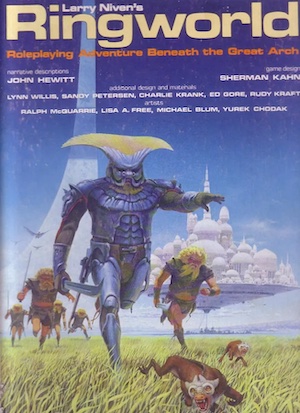
Publisher Chaosium was no stranger to tie-in roleplaying games, having adapted properties from Elric to Elfquest2. Their Call of Cthulhu is one of the great success stories of the industry. However, their Ringworld game is a particular standout, at least for me.
The box was deceptively light. Inside were four saddle-stitched books, into which were crammed a stupendous amount of information. Not only did Hewitt, Kahn, et al. opt for a microdot-sized font, they managed to provide more pages of material than there were technically pages on which to provide it. Additionally, the game had production values almost unheard of at the time. Lisa A. Free’s art was only one of the attractions. Although some material had to be deferred to the Ringworld Companion, the box contained material sufficient to run a Known Space game, not merely the Ringworld-focused campaign the title suggests.
Alas, Chaosium only had time to produce the main game and the companion before they lost the rights. Ringworld is out of print and surviving copies are not cheap. Happily, readers may comfort themselves with the knowledge that I know where my copy is…
Star Wars: The Roleplaying Game by Greg Costikyan (1987)
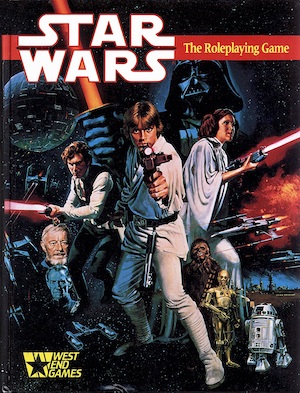
Gosh, you say, perhaps a tie-in product for a movie whose prodigious sales arguably reshaped the film industry might have just the tiniest smidgen of profit motive. I freely grant that, but consider: in 1987, the most recent Star Wars movie was four years old and there was no prospect of a fourth movie on the horizon. Getting the rights to make this game was a big win for publisher West End Games, but not quite the mega-hit that modern readers might expect from the title.
The core rulebook was a perfectly functional set of rules pitting virtuous Resistance against the Empire. Where Star Wars stood out was the prodigious quantity of authoritative material produced while WEG had the rights. Again, some readers might point out that profit might explain that as well, in that it’s hard to sell product that does not exist. However, WEG’s Star Wars source books were of sufficient quality that they provided the foundation of the late, lamented Star Wars Expanded Universe.
Dragonbane: Mirth and Mayhem Roleplaying by Tomas Härenstam (2023)
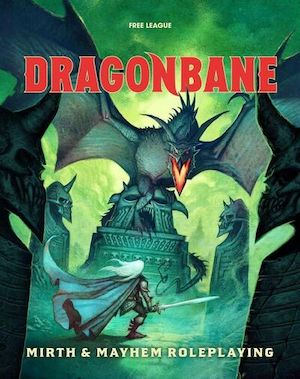
Dragonbane is the English language version of the most recent edition of the venerable Swedish tabletop fantasy roleplaying game, Drakar och Demoner (DoD). Originally a translation of Chaosium’s Basic Roleplaying (BRP) and the Magic World setting from Worlds of Wonder, Drakar och Demoner evolved considerably over the decades, despite which it is possible to see the BRP bones under the DoD skin.
The hefty box set contains an impressive assortment of books, cards, dice, and cardboard figures. While I assume publisher Free League would really appreciate it if you purchased the Bestiary and the campaign Paths of Glory as well, there is sufficient material in the set for a lengthy campaign. Gameplay combines the player-character fragility one expects from a BRP-derived games with heroic-level challenges. Good thing character generation is so fast.
Brindlewood Bay by Jason Cordova (2022)
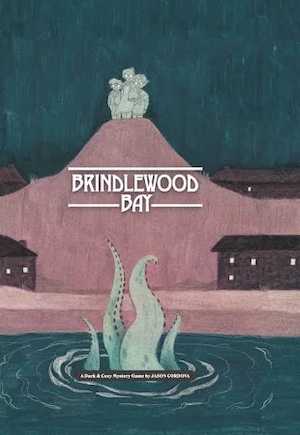
Of all of the tabletop roleplaying games focused exclusively on retired women who solve murders in a small town whose mundane surface hides unspeakable secrets—well, Brindlewood Bay is the first I’ve ever encountered. Odd, given the popularity of crime-solving retirees, crime-solving women, and homicide-prone small towns3.
Based on the popular Powered by the Apocalypse game system, Bridlewood Bay is essentially Murder, She Wrote meets Call of Cthulhu. The mystery element is engaging; the game mechanics encourage a wide assortment of characters4. I suspect the game would be fun even without the lurking unknown waiting in the shadows.
Fabula Ultima by Emanuele Galletto (2023)
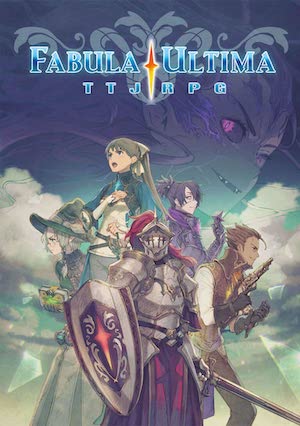
Fabula Ultima is a lavishly illustrated homage to Japanese roleplaying games. The rules are straightforward, clearly presented5, and extremely flexible; there seem to be about five billion permutations possible for starting characters. Although the core rulebook and some dice are really all you need, the game is well supported by its publisher and has an avid online community.
I am not a fan of character class and level-based games and yet Fabula Ultima, which is a class and level-based game, has eaten my brain since I first encountered it back in October. It is a good thing for me that it is so reasonably priced.
Any fun, noteworthy tabletop RPGs I’ve overlooked? Feel free to mention them in comments.
- Could game designers have wildly misplaced expectations? As game designers are artists, and artists are renowned for their keen grasp of financial realities, I think we can rule out misplaced expectations.
- There’s an ongoing Kickstarter campaign for a revival of Chaosium’s Elfquest. Just in case you would be interested.
- A decade or so ago, all too many of the books I was sent for review featured widowed or divorced women protagonists who had left a big city career for a small town, where they worked in some small business, found a new guy better than the old guy, adopted or fostered a kid, and solved murders on the side. It was surprising how diverse the resulting books were.
- For the record, my character Ruby did not murder her five late husbands. Each of them died of natural causes, illnesses, and tragic accidents, as proved by the coroner’s reports she can produce on a moment’s notice. Ruby is currently looking for lucky husband number six. Advanced age, heart conditions, or acute sensitivity to rare toxins found only in the mantle of a nearly extinct cephalopod native to Tuvalu are no impediment.
- You’d think with so many RPGs being published as PDFs, the text would be formatted to facilitate reading. In practice, most companies like double-columns, which means lots of scrolling up and down. Fabula Ultima is laid out to be readable on a tablet or phone.










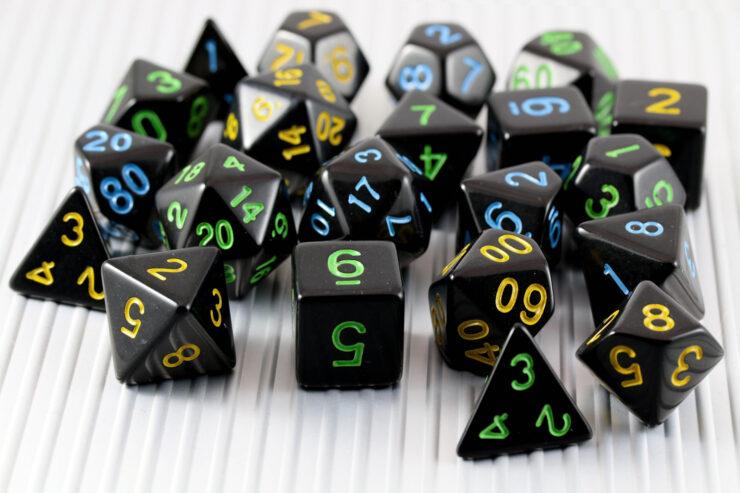
I’ve always enjoyed Savage Worlds by Pinnacle games. Savage Worlds is light on rules, genre agnostic, with an emphasis on story telling. This is a really great system to use if you want to create your own setting or adapt your favorite show/book.
I and others would argue that Savage Worlds is not rules light, it’s rules efficient.
Speaking of Kickstarter funded tie-in RPG revivals, the venerable DC Heroes Roleplaying Game, out of print since 1994, is being revived. I did not expect to ever see that game live again. I’d link but the site won’t let me.
Will it still have it so that Superman would make a better Green Lantern than Guy Gardner?
FTW what freeflogiddyflam I’m talking about, IIRC the Green Lantern’s Power Ring effectiveness is based off the Will stat of the wielder. Superman had a Will of 20 while Guy Gardner had a Will of 18. For the record, the other Green Lanterns had Wills in the range of 22-25.
I mean, there’s a host of reasons why Superman would make a better Lantern than Guy. . .
Wasn’t it canon that Kal El could have been one of the greatest Green Lanterns had other events not precluded that?
In the comics, Lobo was able to force his way through a Guy Gardner force bubble with sheer will. The game stats do not reflect that. Lobo’s Will is only 9 to Guy’s 18 [1] but as Lobo accomplished his feat during the Nice Guy era, after Guy’s personality changed due to Batman induced head trauma, maybe Guy was not at his most determined.
1: The difference is much larger than it may seem to non-DCH players. Each additional point represents a doubling of the aspect measured. Guy’s Will is two to the power of nine times larger than Lobo’s.
I seem to remember a story from the 1970s that did address Kal El being a Lantern had circumstances been otherwise.
Confused the Elseworlds story Superman: Last Son of Earth with the classic Superman story Must There Be a Superman? that was written by Elliot S. Maggin (which featured the Guardians of the Universe) in Superman 247 back in the ’70s…sorry…
It is oddly satisfying to learn which game spawned your character Ruby. I need to find a role playing group and play this game.
Seconding this.
Just downloaded the Fabula Ultima Press Start from DriveThruRPG, look forward to reading it. Yeah, it’s sad when companies release RPG books as PDFs in two-column format.
I picked up the FU main pdf on the advice of a friend, read part of it on a night when gaming was cancelled, then bought every product available for it and downloaded the freebies.
I literally just grabbed every star wars rpg book this past week! I’m a huge fan of Traveller (which should ABSOLUTELY have been included in this list) and Tiny Dungeons, so when I saw that Star Wars was also a classless/levelless, d6 system I was extremely excited to check it out. My friend group is decently into star wars and I’ve already sold them on the system once we are done with Tiny Dungeons.
Traveller was not mentioned because I have and will mention it elsewhere many, many times.
Bless y’all for writing about roleplaying games that aren’t solely D&D or generic fantasy.
Don’t have any other games I could suggest, but I’d be overjoyed to recommend for any lover of RPGs, Stu Horvath’s “Monsters, Aliens, and Holes in the Ground: A Guide to Tabletop Roleplaying Games from D&D to Mothership,” which does a great job of spotlighting a lot of the most important RPGs of the last 50 years, as well as a lot of the least important but at least very interesting and weird games. It’s a $50 book, but it’s worth the price and is incredibly re-readable…
The Star Wars RPG was fun while it lasted, and the amount of information they gave made it possible to come up with adventure plots that weren’t just “fight the evil empire” rehashes – there was good money as a bounty hunter, for example, which let me snipe Jar Jar Binks from several hundred yards in one convention game I played (and put the gunsight video footage onto the empire’s equivalent of youtube for several billion hits which paid better than the contract itself).
I was never quite convinced by Ringworld – I would have been happier if they’d started with a Known Space RPG and added a big Ringworld supplement later. It felt like I was being forced into a relatively narrow corner of a bigger universe, and one type of adventure – unless you wanted to set up an empire on the Ringworld or something, about the only thing to do that made sense was try to leave the place, and the mechanisms for getting trapped there in the first place were fairly high on the “every spaceship designer in known space is an idiot” scale.
I remembered RW RPG as being very RW focused, and was surprised when I reread it to see there’s enough Known Space material to run a campaign there.
The only game on this list that I’ve played is Dragonbane and I absolutely love it!
I will recommend Perils & Princesses, a rules-light game largely based on fairy tales in all of their whimsy. Also, Cloud Empress is a great game using the Mothership RPG (sci-fi horror) rules and set in a world inspired by Miyazaki’s Nausicaä.
Let’s not forget Torg. First published by West End Games in 1990, it had a curious advertising campaign for its introduction to the RPG market. The first ad to appear in Dragon magazine was a full page that consisted entirely of black storm clouds with a line that stated, “The storm has a name,” and the West End Games logo. Over the next several months, similar ads consisting of black storm clouds, the West End Games logo, and an out of context quote were to be found in Dragon before the actual product was fully revealed.
For those who have never heard of Torg, here’s the quick and dirty. Twenty minutes in the future (or to use the phrasing from the game, “Later today, early tomorrow, sometime next week…”), pan-dimensional invaders arrive, rejecting our reality and substituting their own. The American seaboards became a prehistoric lost land. North Africa became a pulpy adventure realm in the style of Indiana Jones and The Phantom. The British Isles and Scandinavia became a D&D type fantasy realm. France became a cyberpunk theocracy. Indonesia became a Gothic horror realm with a touch of Lovecraft. Japan was subjected to a more subtle invasion from a realm of corporate espionage (think cyberpunk without the cyberware). Also ninjas. Later, a post-apocalyptic realm ruled by cybernetically enhanced demons (think a crossover of Terminator and Road Warrior with creative control given to Clive Barker) whose initial invasion of Russia was thwarted manage to get a foothold in Los Angeles. The reason for this mass invasion is because Earth is rich in Possibility Energy. So rich in fact that if a single cosm were to make an attempt by themselves, the resulting backlash would obliterate the invading force. With multiple cosms invading simultaneously, the effect is weakened. Players characters are Storm Knights, so called because they’re better able to maintain the axioms of their native reality when subjected to the reality storms of the invading cosms instead of being forced to conform to the new reality.
The original Torg introduced some innovative features. The most prominent of these was the Drama Deck, which determined initiative during combat, regulated the pace of Dramatic Tasks, and provided players with all sorts of boosts. It also employed what could be considered a true d20 system, in that a single d20 was the only die a player needed. Then there was the Infiniverse newsletter, which would provide details on how the Possibility Wars were going. It also offered rumors, with subscriber response determining which ones would be true. Subscribers were also encouraged to send in the results of their sessions, which would be used to determine the direction the setting took.
While initially successful, Torg quickly ran into problems. There were the inevitable factors of power creep and poor quality control with the supplements (in particular the rushed release of the Living Land Sourcebook gave a bad first impression that it never truly recovered from). But the key issue had to do with the Infiniverse campaign. Perhaps if a mature Internet had existed at the time, it could have worked. But the necessity of snail mail discouraged widespread participation in the long run. Infiniverse was also responsible for introducing some silly elements, often to the setting’s detriment. The edeinos of the Living Land were especially prone to falling victim to this. Eventually, West End went belly up and that was that.
That is until eventual rights holder Ulisses Spiele launched a Kickstarter in 2017 for a reboot called Torg: Eternity. One of the more interesting aspects of the campaign was a War of the Worlds style Twitter feed where the opening days of the invasion were recounted through tweets. Also, during a Reddit AMA one person asked what Torg is and got the following response: “Imagine an RPG with an adventuring party consisting of John McClane, Harry Potter, Van Helsing, Captain America, Lara Croft, and Jackie Chan. One week they travel to New York to race against Belloq to find treasures in Land of the Lost. The next week they go to Cairo to fight ninjas in the world of Raiders of the Lost Ark. The following week they go to France and fight the Spanish Inquisition in the Matrix. And all three of those settings are in the same world. That’s Torg.”
Now you might be asking, “What is a Torg?” The real-world answer is that, when West End first created the game, Torg was an acronym for The Other Roleplaying Game and used it as a placeholder until they could come up with a better name. Which they kind of didn’t. Whoops! The in-game answer is that the High Lords (the leaders of the invading forces) each aspire to become a godlike entity known as the Torg. This is theoretically accomplished by collecting a massive amount of Possibility Energy and using it to meld with their Darkness Device (artifacts that allow the breaking of barriers between cosms and the wholesale collection of Possibility Energy). For the fun answer, take the What is a Sampo? sketch from The Day the Earth Froze and change the opening lines thusly:
Joel: No Tom, you’re thinking of Tor. T-O-R. We’re talking about Torg with a G.
Tom: Okay, so if a Torg isn’t a 400 lb. Swedish wrestler, then what, I implore you, is it?
Then go through it as is, replacing each instance of Sampo with Torg and each instance of Witch with Gaunt Man.
The trouble with Torg is that if you don’t want to play a Big Damn Hero or (if the GM) don’t want to use their official settings and campaign there are huge problems. I’d sooner go with a system that provides some alternatives.
Well, yes. If you don’t want to play TORG, play something else. That same thing could be said about all the RPGs in the article: if you don’t buy into the main conceit, then you won’t enjoy them. If you aren’t up for exploring a giant artificial structure full of weird hominids, the Ringworld RPG isn’t gonna be your cup of tea. Setting-agnostic RPGs would be a whole other article.
The tabletop RPG marketplace is bigger than it’s ever been, which is great. Sadly, D&D is most folks’ go-to, when there are so many more games out there, but hey.
This said, anybody reading this blog post should check out LANCER. It’s got gorgeous artwork of its giant robot mayhem, and provides a rather crunchy, tactical feel in play– but at the same time, the setting is a wonderfully mad bit of worldbuilding (universebuilding?) that can get really wild in some of the mecha options. Like the robot that shoots you with the CONCEPT of a gun (that is not a gun). There’s also the sister game BATTLEGROUP, about big fleet space combat in the same setting, that’s specifically designed to be played over discord.
Alternately, MOTHERSHIP is a really neat horror RPG– it’s deliberately stripped down and modular, which makes every campaign ridiculously customizable. If anything the mechanic where death checks are rolled underneath a cup and not revealed ’til another player goes to poke your body is wonderfully thematic.
My go-to big robot game is still Jovian Chronicles.
The Ringworld mention reminded me of the other Niven (and Barnes) setting (that I know of) that got adaptated to an RPG: Dream Park! The books, for those not familiar, take place in the eponymus theme park, the central attraction of which is a really elaborate LARP setup complete with simulated wilderness, actors playing NPCs, etc. The stories take place largely in the games but are usually about a murder mystery (or industrial espionage, possibly other crimes, it’s been a while). The RPG, then, has the players sit around a table (in the late 20th century when the game came out) and make characters who are relatively ordinary 21st century people. Then they roleplay their characters making their characters for the LARP, and proceed to roleplay their character roleplaying their characters.
Unsurprisingly, it was not a big seller.
Love Fabula Ultima, especially with the Techno Fantasy supplement. Also a shout at to Scum and Villany, which uses the Blades in the Dark engine for a space outlaw campaign.
PDFs with double columns are very poor.
Honourable mention for the WARHAMMER FANTASY ROLEPLAYING GAME, mostly because it can best be summed up as ‘DUNGEONS AND DRAGONS by Monty Python’ (Lots of grubby little peasant professions to make a change from actual professional adventures, not to mention small, vicious dogs).
I’ve just started playing Salvage Union. This is the game I didn’t know my inner Jawa needed.
I almost feel like West End’s Star Wars is getting slightly short shift here. Greg Costikyan was one of the most interesting game designers of the 1980s, and Star Wars built on the work he did on WEG / Chaosium’s Ghostbusters RPG to produce one of the earlier dice pool RPG systems. One that’s still very fast, pretty intuitive, and very playable.
Maybe more importantly, Costikyan was also a legitimately funny writer when he wanted to be, and WEG’s Star Wars has something subsequent licensed games and much of the franchise at large has lacked since the ’90’s: a sense of fun. This was a game that had a color insert advertising R2 units that was recognizably modeled on computer ads from the era, an example of play that involved disguising an Ewok with a flute as an astromech droid, and a character class that was basically some random person who’d fanboied themself into thinking they were a Jedi who somehow lost their lightsaber.
Star Wars today could stand to take itself as unseriously as the WEG game took it even while being entirely respectful to the source material.